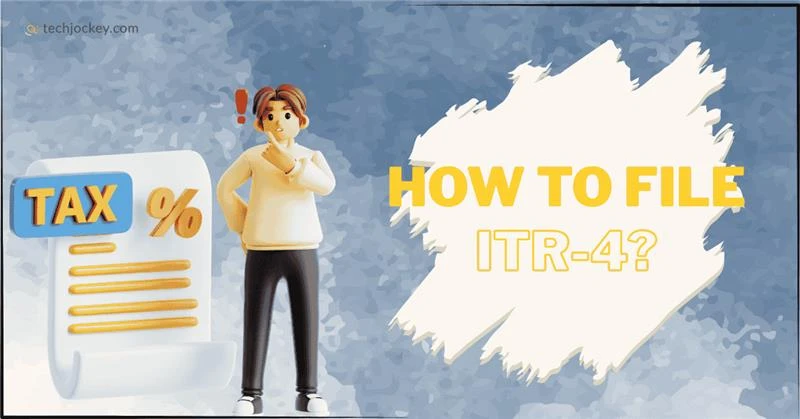
It’s that time of the year when you file your income tax returns! If you are a small business owner or a hustling freelancer, however, the forms and the technicalities involved in filing them are your biggest nightmares. What if I make a mistake or worse, miss the deadline? You keep wondering, as sweat trickles down your face.
But hey, what if we make the ITR filing process easy for you? Let’s start with ITR-4 (Sugam). Mastering how to file ITR-4 online can not only save you time, but also the stress that it brings along. Let’s go!
ITR-4 is an income tax return form that taxpayers who have income from business or profession and opt for presumptive taxation under Sections 44AD, 44ADA, or 44AE of the Income Tax Act are required to file. It, as such, caters to resident individuals, HUFs, and partnership firms (excluding LLPs) whose total income does not exceed INR 50 lakh during any given financial year.
Those eligible for ITR-4 return filing can report the following income…
ITR-4 simplifies the tax filing process by helping small businesses and professionals get rid of detailed books of accounts and declare income on a presumptive basis.
Before you file ITR-4 online, ensure you have the following documents handy…
If you keep the aforementioned list of documents ready, your ITR-4 filing process will surely become as easy as sipping tea.
Filing your ITR-4 online isn’t a tough nut to crack, but it requires precision. Here’s a detailed guide on how to file ITR-4 step by step so you can attain the same…
Step 1: Log in to the Income Tax e-Filing Portal
Step 2: Select the Assessment Year & ITR Form
Step 3: Verify Personal Information
Step 4: Fill in Gross Total Income
Note: Ensure presumptive profit rates are correctly applied.
Step 5: Disclosures and Exempt Income
Disclose….
New Requirement: If you have opted out of the new tax regime in previous years, you must confirm past filings of Form 10-IEA and whether you wish to continue opting out.
ClearTax Income Tax
Starting Price
Price on Request
Step 6: Declare Deductions
Note: Under the new tax regime, most deductions are not allowed except for specific ones like NPS employer contributions.
Step 7: Taxes Paid
Verify…
New Requirement: Mention the TDS section under which tax was deducted (e.g., 194A for interest income).
Step 8: Preview and Validate
Step 9: Submit and Verify Your Return
Submit the return online and verify it within 30 days using…
Note: If not verified, the return will be treated as invalid.
Step 10: Save Acknowledgment
To understand how to fill ITR-4 with an example, consider Mr. Sharma, a freelance consultant who earns INR 40 lakh under presumptive taxation (Section 44ADA), INR 5 lakh from salary, INR 1 lakh from house property, and INR 50,000 as interest income. As per his income sources, he is required to file ITR-4.
To do the same thus, he will have to enter his income details under the respective heads to claim deductions of INR 1.5 lakh under Section 80C and INR 25,000 under Section 80D.
You can download ITR-4 (Sugam) in the following two ways…
ITR-4 is for individuals, HUFs, and firms (other than LLP) opting for presumptive taxation. If audit is not required, the return must be filed by 15 September 2025. If audit provisions apply, the due date becomes 31 October 2025, and in cases involving international/specified domestic transactions, the return is due by 30 November 2025.
Filing your ITR-4 correctly is necessary in order to stay clear of notices and penalties. Here are some blunders that you need to watch out for…
Conclusion
If you know how to file ITR-4 online, you, as a small business owner or working professional, can adhere to tax laws in India without putting in much effort. All you then need to do is stay updated with notifications from the Income Tax Department, so you don’t miss out on anything.
For those requiring additional tech help to facilitate their ITR-4 filing process online, we have specialised income tax software like GEN Income Tax Software, Saral IncomeTax, etc., as well. You just need to give our product team a call to get things sorted for you!
When you begin your building information modeling journey, selecting the right software is crucial. Your… Read More
Highlights: The Digital Personal Data Protection Act, India, 2023 is the first comprehensive law in… Read More
Smart technology assists us in our daily lives, and it is operating silently in the… Read More
The holiday season is all about cozy lights, warm emotions, and picture-perfect memories and now,… Read More
Android trojan, for the unversed, is malware that poses a serious threat to mobile… Read More
Smartphones have completely transformed how we bank, making money transfers and payments quicker and more… Read More